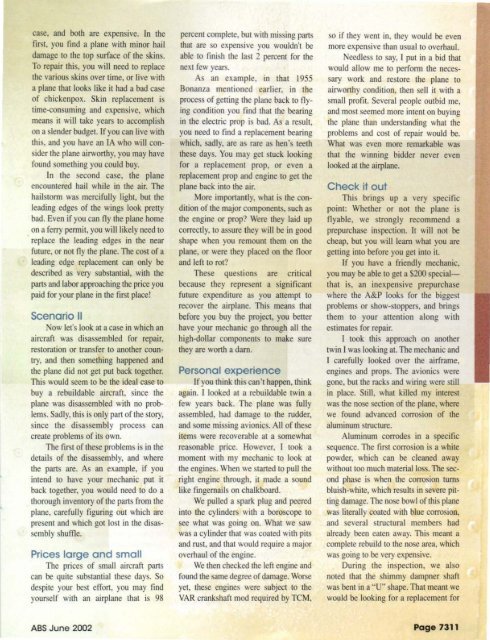Create successful ePaper yourself
Turn your PDF publications into a flip-book with our unique Google optimized e-Paper software.
case, and both are expensive. In thefirst , you find a plane with minor haildamage to the top surface of the skins.To repair this, you will need to replacethe various skins over time, or live witha plane that looks like it had a bad caseof chickenpox. Skin replacement istime-consuming and expensive, whichmeans it will take years to accomplishon a slender budget. If you can live withthis, and you have an IA who will considerthe plane airworthy, you may havefound something you could buy.In the second case, the planeencountered hail while in the air. Thehailstorm was mercifully light, but theleading edges of the wings look prenybad. Even if you can fly the plane homeon a ferry permit, you will likely need toreplace the leading edges in the nearfuture, or not fly the plane. The cost of aleading edge replacement can only bedescribed as very substantial, with theparts and labor approaching the price youpaid for your plane in the first place!Scenario IIow let's look at a case in which anaircraft was disassembled for repair,restoration or transfer to another country,and then something happened andthe plane did not get put back together.This would seem to be the ideal case tobuy a rebuildable aircraft, since theplane was disassembled with no problems.Sadly, this is only part of the story,since the disassembly process cancreate problems of its own.The first of these problems is in thedetails of the disassembly, and wherethe paris are. As an example, if youintend to have your mechanic put itback together, you would need to do athorough inventory of the parts from theplane, carefully figuring out which arepresent and which gO! lost in the disassemblyshuffle.Prices large and smallThe prices of small aircraft partscan be quite substantial these days. Sodespite your best effort, you may findyourself wi th an airplane that is 98percent complete, but wi th missing partsthat are so expensive you wouldn't beable to fi nish the last 2 percent for thenext few years.As an example, in that 1955<strong>Bonanza</strong> mentioned earlier, in theprocess of getting the plane back to flyingcondition you find that the bearingin the electric prop is bad. As a result,you need to fi nd a replacement bearingwhich, sadly, are as rare as hen's teeththese days. You may get stuck lookingfor a replacement prop, or even areplacement prop and engine to get theplane back into the air.More importantly, what is the conditionof the major components, such asthe engine or prop? Were they laid upcorrectly, to assure they will be in goodshape when you remount them on theplane, or were they placed on the floorand left 10 rot?These ques ti ons are criticalbecause they represent a significantfuture expenditure as you attempt torecover the airplane. This means thatbefore you buy the project, you benerhave your mechanic go through all thehigh-dollar components to make surethey are worth a darn .Personal experienceIf you think this can 't happen, thinkagain. I looked at a rebuildable twin afew years back. The plane was fullyassembled, had damage to the rudder,and some missing avionics. All of theseitems were recoverable at a somewhatreasonable price. However, I took amoment wi th my mechanic to look atthe engines. When we started to pull theright engine through, it made a soundlike ftngemails on chalkboard.We pulled a spark plug and peeredinto the cylinders with a boroscope 10see what was going on. What we sawwas a cylinder that was coated with pitsand rust, and that wo uld require a majoroverhaul of the engine.We then checked the left engine andfound the same degree of damage. Worseyet, these engines were subject to theVAR crankshaft mod required by TeM,so if they went in, they would be evenmore expensive than usual to overhaul.Needless to say, J put in a bid thatwould allow me to perform the necessarywork and reslOre the plane toairworthy condition, then sell it with asmall pro fi t. Several people outbid me,and most seemed more intent on buyingthe plane than understanding what theproblems and cost of repair would be.What was even more remarkable wasthat the winning bidder never evenlooked at the airplane.Check it outThi s brings up a very specificpoint: Whether or not the plane isflyable , we strongly recommend aprepurchase inspection. It will not becheap, but you will learn what you aregetting into before you get into it.If you have a friendly mechanic,you may be able to get a $200 specialthatis, an inexpensive prepurchasewhere the A&P looks for the biggestproblems or show-stoppers, and bringsthem to your attention along withestimates for repair.I took this approach on anothertwin I was looking at. The mechanic andI carefully looked over the airframe,engines and props. The avionics weregone, but the racks and wiring were stillin place. Still, what killed my interestwas the nose section of the plane, wherewe found advanced corrosion of thealuminum structure.Aluminum corrodes in a specificsequence. The first corrosion is a whitepowder, which can be cleaned awaywithout too much material loss. The secondphase is when the corrosion turnsbluish-white, which results in severe pittingdamage. The nose bowl of this planewas literally coated with blue corrosion,and several structural members hadalready been eaten away. This meant acomplete rebuild to the nose area, whichwas going to be very expensive.During the inspection, we alsonoted that the shimmy dampner shaftwas bent in a "U" shape. That meant wewould be looking for a replacement forABS <strong>June</strong> <strong>2002</strong>Page 7311
















